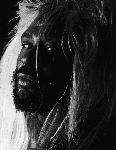Forget Apollo, NASA and the Space Shuttle... the most exciting
explorations of space in the last 30 years have been carried out
through music.
Emerging on the radical fringes of jazz in the 1950's Sun
Ra (1914-1993) and his Intergalactic Research Arkestra (as
his band was later known) set the space vibe in motion with interstellar
explorations like 'Space Jazz Reverie', 'Love in Outer Space',
'Disco 3000', and the film 'Space is the Place'.

Described by one critic as "a comic strip version of Sun
Ra", George Clinton developed his own funky
cosmic Afronaut
mythology in the 1970's through his work with Funkadelic
and Parliament. For instance, the album "Mothership Connection"
(1975) is based around the concept of aliens visiting earth to
take the funk back to their own planet.
Sun Ra and Clinton's work can be read as a sort of sci-fi take
on Marcus Garvey. While Garvey dreamt of Black Star Liners shipping
back people from slavery across the ocean to an African utopia,
they leave the planet altogether.
Space continued to be a preoccupation during the 1970s disco boom.
Derided by rock critics for its lack of serious content, disco
had a distinct utopian element. In disco the intensity of pleasure
on the dancefloor was reimagined as an ideal for living rather
than just a Saturday night release. The implicit fantasy was of
a 'Boogie Wonderland' where music, dancing and sex were organising
principles rather than work and the economy. "Lost in music,
feel so alive, I quit my nine-to-five", as Sister Sledge
put it.


In the unpromising social climate of the 1970's, this wonderland
was sometimes projected into space. Earth,
Wind and Fire (who recorded 'Boogie Wonderland') combined
elements of Egyptology and sci-fi with albums like 'Head for the
Sky' (1973) and 'All n All' (1977) with its cover pic of a rocket
taking off from a pyramid. In the late 1970s there was a rash
of space themed disco hits like Sheila B. Devotion's 'Spacer'
and Slick's '(Everybody goes to the) Space Base' (1979), the latter
imagining the space base as disco and social centre rather than
military-industrial installation.

Some of these space records can be viewed as simple cash-ins
on the popularity of Star Wars and similar films of this period,
but was there something deeper going on? While the sale of disco
records reaped big profits for the record companies, the logic
of the dancefloor was potentially at odds with the society of
domination. On the floor pleasure was elevated above the puritan
work ethic and hierarchies of class, race, gender and sexuality
were (sometimes) dissolved.
Discos (like today's dance spaces) could have been the launchpad
for explorations of different worlds on earth and beyond, powered
by the Dance Disco Heat energy on the floor. In this light the
disco icon par excellence, the glittering mirror ball, has to
be re-evaluated. Detailed archaeological investigations of the
alignment of these spheres of light suspended high above the dancefloor
will doubtless reveal that they were installed to equip dancers
with a rudimentary astronomical knowledge to help them find their
way around the universe.